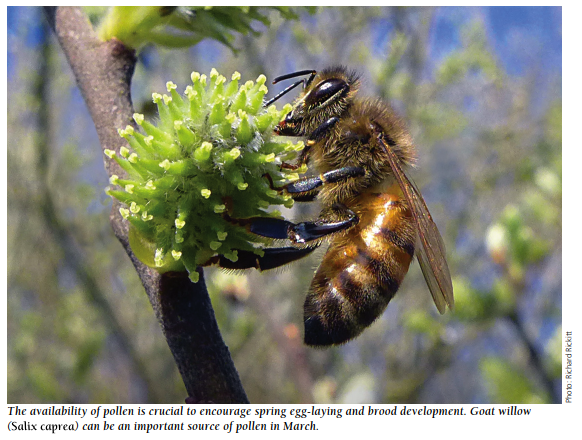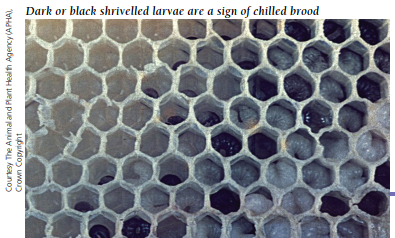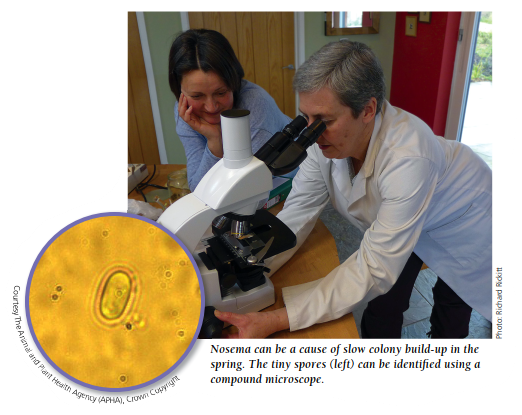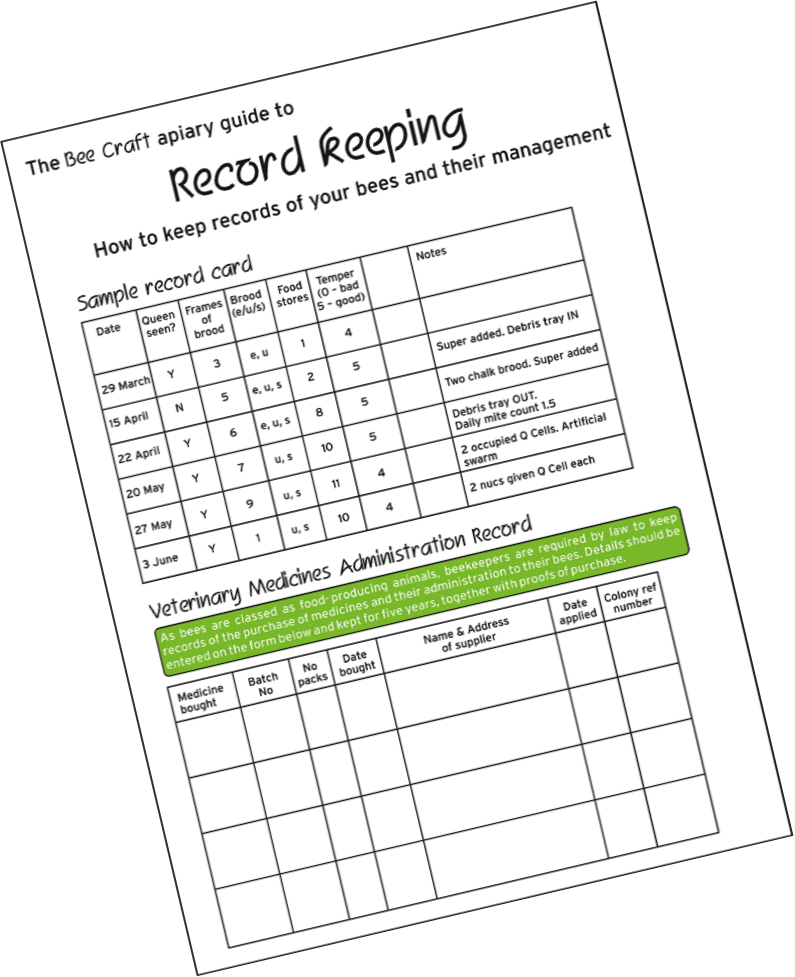Margaret Murdin, NDB, BBKA President
 I'm an optimist, so I am looking forward to the coming season. I am quite sure that the next season will be better than the last, I will have healthy bees and the weather will be fine. Oh, and my bees will not swarm.
I'm an optimist, so I am looking forward to the coming season. I am quite sure that the next season will be better than the last, I will have healthy bees and the weather will be fine. Oh, and my bees will not swarm.
Where I live, in north Oxfordshire, many of the spring flowers and plants have been out for some weeks and on warm days the bees have been foraging. It is the appearance of these flowers and the increased warmth which signal the end of winter for the bees. The flowers provide pollen, which is necessary for the development of the larvae. It is the availability of this pollen which encourages the workers to increase the feeding rate of the queen, and the queen, in turn, to increase her laying rate.
 Most of the old winter bees will have died by now and you may well find them on the floor of the hive when you do your first inspection. With luck, they will have died naturally, having lived through the winter and sustained the first young of the new season.
Most of the old winter bees will have died by now and you may well find them on the floor of the hive when you do your first inspection. With luck, they will have died naturally, having lived through the winter and sustained the first young of the new season.
The number of new workers will be increasing steadily, but they will be under great strain. If you remember the graph from last month (February, page 18), you will know that at this time of the year there are more larvae than adult bees and the adults can struggle to provide sufficient food. They must feed the queen as well as the larvae, keep the brood nest warm and forage for pollen and nectar.
Spring Surprises
As long as the bees are healthy and the weather is kind, then all should be well. However, as we all know, British spring weather is unpredictable and can turn very cold suddenly and unexpectedly. When this happens, the colony may return to its cluster and the larvae on the extremities of the brood nest can become cold and neglected, leading to a situation called ‘chilled brood’. Usually this happens to drone brood which is at the edges of the brood nest. The perfectly formed larvae will turn black and we may well suspect disease. But the colony as a whole is just protecting itself and the dead larvae will be removed and more eggs will be laid once the weather improves.
Colony Strength
 Under normal circumstances, the colony should be starting to build up steadily. If you have more than one colony, it is important to compare them and check that they are all developing at about the same rate.
Under normal circumstances, the colony should be starting to build up steadily. If you have more than one colony, it is important to compare them and check that they are all developing at about the same rate.
If one colony is considerably weaker than the others, or slower to build up, then you could have what used to be called ‘spring dwindle’. If this is the case, check for nosema, an infection which can be a danger at this time of year.
You need to take a sample of about 30 of the older adult bees and, after killing them in the freezer or with ethyl alcohol, grind up their abdomens with a little water. Place a drop of this mix on a glass slide and checked for nosema spores using a compound microscope with x 400 magnification. Most branches now have a microscopist who can help you with this.
If nosema is present, then, as soon as it gets a bit warmer, you can carry out a comb change specially designed for a weak colony. If you are unsure how to do this, have a look on BeeBase (www.nationalbeeunit. com) where the process is described in detail. The disease organisms are likely to be on the comb, so giving the colony fresh, new comb, particularly disinfected drawn comb, will give them a boost.
Keeping Records
 Checking colony build- up is one of the reasons for keeping accurate colony records. And if you have not kept records before, then spring is a good time to start.
Checking colony build- up is one of the reasons for keeping accurate colony records. And if you have not kept records before, then spring is a good time to start.
You can buy ready-made record cards from the Bee Craft website, but it is also possible to make your own.
In his book, Guide to Bees & Honey, Ted Hooper recommends that we check five things every time we examine a colony and we should record these as a minimum.
- Is the queen present and laying? It is not necessary to find the queen. In fact, if we go into the brood box at all in March, we must do so only if the temperature is above about 12 °C – and then only briefly. Please resist the temptation to hunt for the queen. Just check for eggs. If eggs are present, then you know the queen was there within the last day or two.
- Are there enough stores to last the colony until your next visit? At this time of year the weather is changeable and you may not be able to open the hive for a few weeks. And, of course, the bees are using their stores rapidly because they are more active and are feeding the queen and the brood. If you are in doubt about the amount of stores, then you can place a patty of fondant directly on top of the brood frames. Similarly, if there is a shortage of pollen rich plants near the apiary you can feed a pollen patty. The bees will ignore them if there is enough natural forage available.
- Is disease or abnormality present? We have talked about nosema, but don’t forget that varroa is still the biggest killer of our bees. The mites have not gone away even if the count is low because they will be reproducing in the sealed brood. If you haven’t already done so, put the varroa slider under your hive and check the number of mites that fall over a seven-day period. Then either check the calculator on BeeBase, or look in the NBU’s pamphlet on varroa and see if further action is needed. Make a note of the daily average and the total count in your records. If your brood area looks healthy and there is a good brood pattern, then note how many frames of brood there are and if they are well covered with bees. Move any frames that you wish to replace to the outside, ready for removal when the weather is warm enough for a full inspection.
- Does the colony have sufficient room for the queen to lay? This should not be a problem in March, but check quickly and make a note on your records.
- Finally, a note should be made of swarm preparations. Colonies are unlikely to be making preparations in March and it is not necessary to go through the hive looking for queen cells. But there should be space for a note in your records.
Peace of Mind
In March, all we really want to know is that all is well. That the queen is laying worker brood with few missed cells, that it looks healthy and that there are enough stores for their increasing needs.



